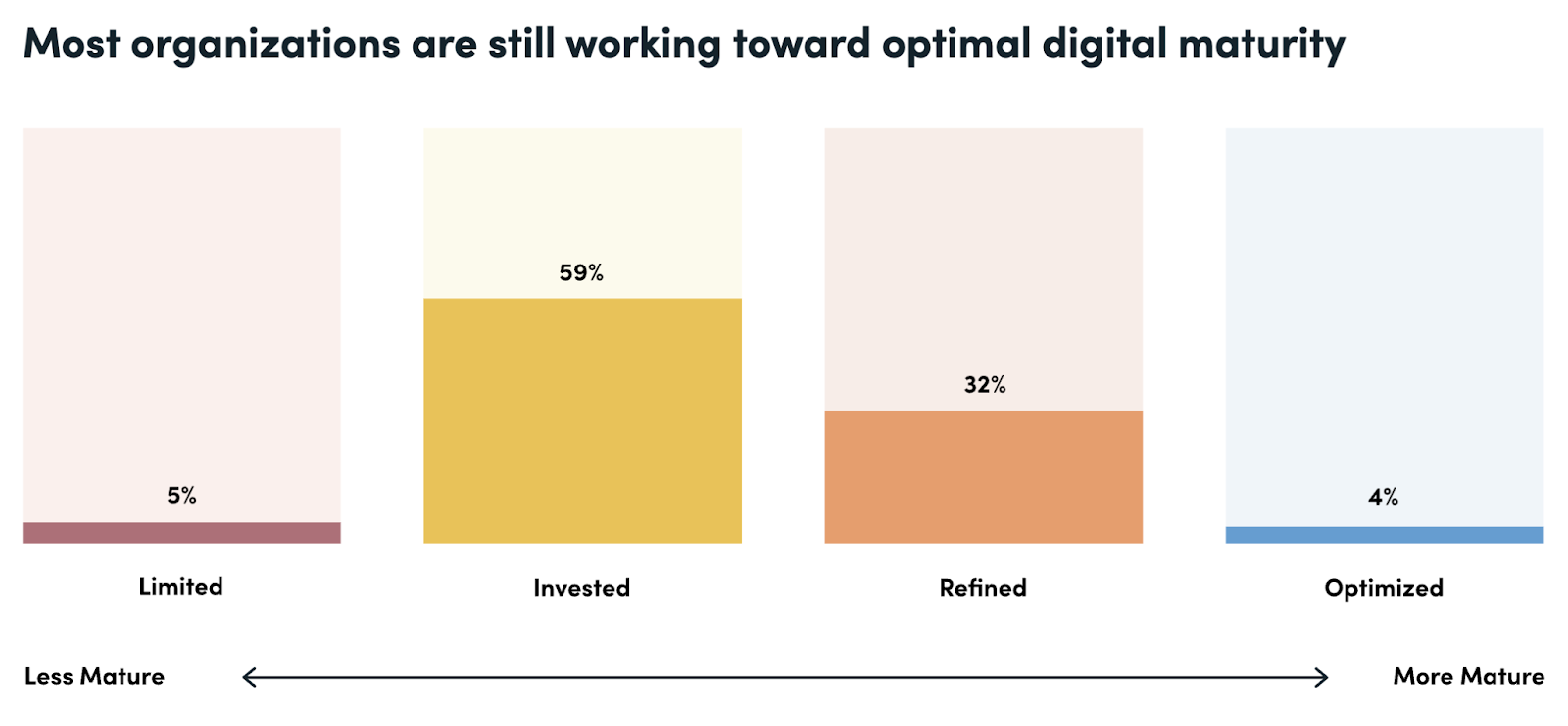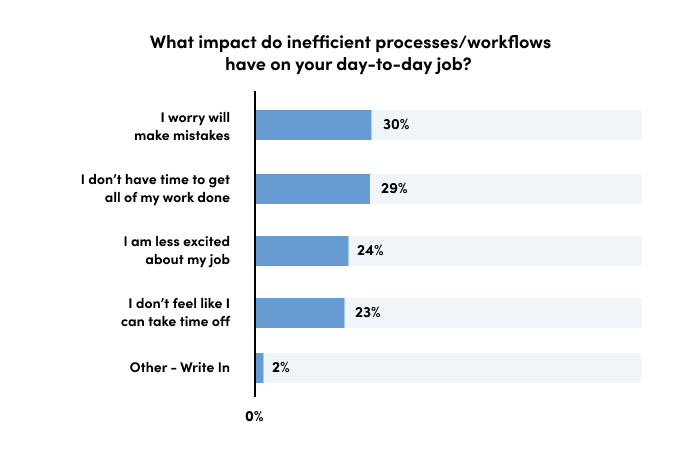What would your reaction be if I told you only 4% of organizations have reached the ideal of a fully automated and digitized workplace?
Would that surprise you? Concern you? Make you wonder why so few organizations are fully digitized?
It definitely surprised us. After all, we’re more than 20 years into the digital age. At the turn of this century, many believed the future of work would be digitized. Yet most of us are not very close to this fully automated, digitally mature workplace we imagined the new millennium would bring. In fact, a majority or organizations are lagging quite far behind.
Why does this matter? We’ll let the statistics from our 2022 State of Digital Maturity report explain.

A Snapshot of Our Process and Findings
Before we dig into the top digital maturity statistics from our report, let’s cover how we gathered this data. We partnered with Mantis Research to survey 2,000 knowledge workers to better understand how organizations are digitizing processes, automating workflows, and improving efficiencies.
We then compared our survey findings against our digital maturity model. This model identifies an “ideal state” of digital maturity based on the pillars of culture, workflow digitization, technology, and team alignment. We identified four stages of digital maturity: Limited, Invested, Refined, and Optimized.

Our research revealed that most organizations have made strides toward digital maturity, but they are still quite far from the fully digitized ideal. 64% of organizations we surveyed have only just begun their digital transformation journey, landing in the Limited and Invested levels. These organizations still rely on paper processes and often struggle to get buy-in for new technology.

Related: Top 3 Reasons You Need to Assess Your Digital Maturity Now
Important Digital Maturity Statistics
So why does digital maturity matter? We found that only 1 in 4 organizations feel prepared to take advantage of opportunities in the market. This means a majority of businesses struggle to quickly adapt to the changing needs of customers, leaving those businesses vulnerable to competitors who are better positioned for change.
Yet 80% of Optimized organizations—the most digitally mature—report feeling very prepared, with the other 20% reporting somewhat prepared. What are these organizations doing differently that sets them up for success? Let’s take a look at a few of our overarching digital maturity statistics to find out.

Have you ever ended your day and felt like you didn’t get much done? There’s a big reason for that: repetitive, inefficient tasks. We found that 51% of workers waste at least two hours per day this way. That adds up to 10 hours per week!
Workers within Optimized organizations spend much less time on those manual, time-consuming tasks. In fact, 53% report spending less than an hour per day and 13% report zero time spent on repetitive, inefficient tasks.

Not only are employees at less digitally mature organizations losing lots of time, they’re also losing their organizations lots of money.
If the average annual wage in the U.S. is $53,383, one employee wasting two hours per day on inefficient tasks costs your organization about $13,345 a year. For an organization of 100 employees, that adds up to more than $1.3 million.
Less digitally mature companies already struggle to take advantage of market opportunities. When you factor in this much money left on the table, it’s clear that improving digital maturity should be a high priority.
Read Next: Key Benefits of Digital Maturity

This statistic isn’t that surprising, considering the impacts of the Great Resignation and COVID-19. But what is surprising is that 33% of Optimized organizations don’t find it challenging at all.
We found that the less digitally mature an organization, the more challenging they find it to retain talented employees. In a tightening talent market with high competition, this can set organizations back even further when trying to achieve their organizational goals and KPIs.

It’s clear that less digitally mature organizations struggle more with retaining their talent. But what factors contribute to this?
Our research found that those repetitive, inefficient tasks bogging down employees at less digitally mature organizations have a huge impact on morale.

Meanwhile, employees at Optimized organizations are generally happier, less stressed, and more productive. This is due in part to their investment in digitization and automation. In fact, 49% of employees at Optimized organizations report inefficient tasks and workflows do not impact their job. This shows the value in reaching this level of digital maturity.

How many times have you tried to get a project off the ground, only to be told IT doesn’t have the bandwidth to assist?
It’s an incredibly common situation. But it’s one Optimized organizations rarely face. In fact, 61% report they rarely or never have projects delayed due to a lack of technical resources. You might assume this is due to higher budget or larger head counts, but that’s not necessarily true.
Here’s a few reasons why Optimized organizations are not held back by technical delays:
- They have an easier time getting new technology approved.
- The tools in their tech stack integrate well.
- They track which systems require the most time from employees.
- There’s insight into which systems are the most costly to maintain.
- They have access to no-code tools.
If you’re trying to decide on the best way to help your organization overcome a lack of technical resources, consider looking into no-code. Your employees will probably thank you or it, since 64% of those who don’t currently have access to no-code tools report they would like to be able to use them.












